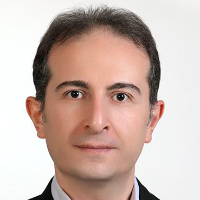The kinetic investigation of moisture sorption and water vapor permeability of starch - cellulose nanocrystal films
In recent years, demand for edible and biodegradable films has increased. One reason for this increase is the pollution caused by synthetic polymers. Edible films are produced from different biopolymers such as lipids, polysaccharides and proteins. Starch is a common polysaccharide in the preparation of edible films which is taken into consideration because of its low price and easy access. Structure and composition of starch-based films affects the resulting film properties such as moisture sorption, gas permeability, plasticizer crystallization, glass transition temperature and its mechanical properties. Starch films have usually poor mechanical properties and are permeable to water vapor. The use of nanofillers such as cellulose nanocrystal (CNC) in the structure of starch films and production of nanocomposite films is one way to modify properties of the films. The most important purpose of the application of edible films is to prevent moisture or other compounds such as carbon dioxide or volatile components transfer between the product and the environment or between different layers of the product. Modeling mass transfer and moisture permeability of edible films can be effective in predicting film properties and packaged product during storage. For example, it can be predicted that at a certain temperature, relative humidity and time, how much moisture packaging material will absorb. Therefore, before using edible film as a protective coating for food, calculation of the amount of moisture sorption and permeability to water vapor is essential. The purpose of this study was to investigate mass transfer in starch - CNC nanocomposite films. The effect of adding different percentages of CNC on the water vapor permeability and moisture sorption kinetics of nanocomposite films was studied
First, 100 ml of potato starch solution with a concentration of 4% (w/v) was prepared by dispersion of the starch in distilled water and was gelatinized at 90ºC for 5 min. Different levels of CNC (0, 3, 5, 7 and 9% w/w) were dissolved in distilled water and were added to the gelatinized starch after treatment with ultrasound for 10 min. Then, glycerol, as a plasticizer, with concentrations of 0.2, 0.3 and 0.4% (w/w) were added to the solution. The film solutions were distributed on polystyrene surfaces and the resulting films were dried in an oven at 40°C for 24 hours. The Fickʹs second law and four empirical equations were used for moisture sorption modeling of samples. The effect of glycerol concentration on water vapor permeability was investigated and the experimental data were fitted with an exponential model.
By increasing the concentration of CNC, moisture content of the nanocomposite films declined. Effective moisture diffusion coefficient values for nanocomposite samples were higher than the pure starch film. The coefficient increased from 0.293×10-13 to 0.547×10-13 m2/s by increasing CNC concentration from 0 to 9%. This result can be attributed to the influence of cellulose nanofibers on the polymer matrix and gaps creation in the polymer amorphous regions. This, in turn, would facilitate moisture diffusivity into the polymer structure. It should be noted that plasticizer presence in the nanocomposite structure can be an important factor. Regarding that plasticizer lead to increase in polymer chain mobility, simultaneous presence of CNC and plasticizer could lead to create gaps in the structure of nonocompositefim. As expected, in the absence of plasticizer, the effective moisture diffusion coefficient in nanocomposite samples decreased by increasing the concentration of nanoparticles due to high immobility of polymer chains. In addition, the initial stages of moisture sorption were well described by the Fickʹs law but due to the polymer relaxation between 2.5 - 9 h interval, its behavior was deviated from this law. Finally, after about 9 hours, it was observed that the equilibrium moisture content of the nanocomposite samples were consistent with the values predicted by the Fickʹs model. Equilibrium moisture content depends on the hydrophilic locations of the nanocomposite structure. These locations have the ability to absorb moisture and this ability is not influenced by changes in the structure of the polymer during the moisture sorption process. Despite higher levels of effective moisture diffusion coefficients in starch-nanocrystalline cellulose nanocomposites compared to pure starch film, moisture content was lower in nanocomposite films. These results are probably due to the nature of nanocrystalline cellulose which is resistant to water and is compatible with the starch polymer. Nanocrystalline cellulose has the ability to make many hydrogen bonds with the hydrophilic polymer matrix. This results in decreasing hydrophilic property of starch. On the other hand, in all samples, the permeability to water vapor reduced with increasing nanoparticles concentration. For example, in the starch film which contained 0.4% glycerol, water vapor permeability was 2.62×10-7g.m/m2.h.Pa; with the addition of nanocrystalline cellulose to 9%, its value was decreased to 1.8×10-7g.m/m2.h.Pa. Moreover, the permeability to water vapor in all cases increased by increasing the concentration of plasticizer. Results also showed that there is an exponential relationship between the water vapor permeability and plasticizer content.
By increasing the concentration of CNC, moisture content of the nanocomposite films declined. Effective moisture diffusion coefficient values for nanocomposite samples were higher than the pure starch film. The coefficient increased by increasing CNC concentration. The initial stages of moisture sorption were well described by the Fickʹs law but due to the polymer relaxation, its behavior was deviated from this law. Finally, after about 9 hours, it was observed that the equilibrium moisture content of the nanocomposite samples were consistent with the values predicted by the Fickʹs model. In addition, in all samples, the permeability to water vapor reduced with increasing nanoparticles concentration. However, the permeability to water vapor increased by increasing the concentration of plasticizer. Results also showed that there is an exponential relationship between the water vapor permeability and plasticizer content
- حق عضویت دریافتی صرف حمایت از نشریات عضو و نگهداری، تکمیل و توسعه مگیران میشود.
- پرداخت حق اشتراک و دانلود مقالات اجازه بازنشر آن در سایر رسانههای چاپی و دیجیتال را به کاربر نمیدهد.



